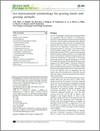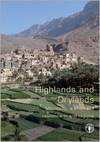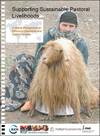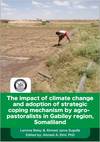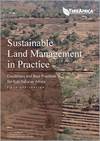This publication presents terms and definitions to ensure clear international communication regarding grazing lands and grazing animals.
Year of publication: 2011Organization: Individual authors
Topic: Environmental services
Language: English
Type of document: Scientific
Geographical coverage: Global
The needs of nomadic pastoralists are generally complex and those relating to the provision of education need special attention due to the many challenges facing the children and the communities. Recognizing this, the Ministry of Education in Kenya, in collaboration with its development partners, has drafted this policy framework to enable Kenya’s nomadic communities to access basic education and training.
The Ministry acknowledges that education cannot be provided to nomadic communities without taking their socio-cultural and other developmental concerns into consideration. Therefore, it proposes multiple approaches such as mobile schools, non-formal schools, formal schools, and boarding schools, as well as creating linkages between these approaches. The policy framework is therefore aimed at providing broad guidelines for the coordination and harmonization of efforts in the delivery of quality educational services to nomadic communities.
Year of publication: 2011Organization: Individual authors
Topic: Education, Gender and youth, Social services
Language: English
Type of document: Policies and legislation
Geographical coverage: Eastern Africa
Los derechos milenarios de los ganaderos a desplazarse libremente por el territorio nacional fueron reconocidos en 1212 en Aragón por Jaime I, con el Fuero de Pastura universal, y en 1273 en Castilla y León por Alfonso X, con la creación del Concejo de la Mesta. La importancia que adquirió la trashumancia en España es debida a la alternancia de recursos pastables alternativos en invierno y en verano, para lo cual los ganados deben desplazarse frecuentemente a larga distancia, entre 400 y 600 Km, recorriendo las cañadas durante 4 o 6 semanas en primavera y algo más en otoño, al ser las noches más prolongadas. El mayor beneficio se obtenía del comercio de la lana de las ovejas merinas, la más fina del mundo, y que se exportaba a todos los países europeos. Constituyó un preciado monopolio español hasta la invasión napoleónica del siglo XIX.
Year of publication: 2011Organization: Asociación Trashumancia y Naturaleza
Topic: Environmental services, Indigenous knowledge, Land
Language: Español
Type of document: Maps
Geographical coverage: Europe
Recognizing the crucial role of dryland mountains in implementing a truly sustainable development, the Food and Agriculture Organization of the United Nations (FAO) together with the Mountain Partnership Secretariat, the UNCCD Secretariat, the Centre for Development and Environment of the University of Bern and the Swiss Agency for Development and Cooperation, identified an urgent need to prepare this publication. It provides an overall vision of the ecological, social and cultural features of dryland mountain socio-ecosystems, and aims to demonstrate the importance of investing human and financial resources in dryland mountains ecosystems worldwide in order to limit the impact of global change on the livelihoods and natural resources.
Year of publication: 2011Organization: Food and Agriculture Organization of the United Nations (FAO)
Topic: Climate change, Environmental services, Finance, Indigenous peoples, Land, Resilience
Language: English
Type of document: Technical
Geographical coverage: Global
This publication contains the keynotes and case studies that were presented in the plenary sessions of the regional workshop on pastoralism and rangeland management in the Tibetan Plateau in the context of climate and global change. With this publication, the authors attempt to reach a wider readership that has an interest in the changes, challenges and transformations in pastoralism and rangeland management. Some of the key concepts, designs for modernisation and aims for the immediate future in the rural areas of the Tibetan Plateau are presented here in a concise and easily approachable manner by leading experts in the respective fields.
Year of publication: 2011Organization: German Agency for International Cooperation (GIZ)
Topic: Climate change, Environmental services, Land, Resilience, Value addition
Language: English
Type of document: Technical
Geographical coverage: Central Asia, South Asia
These guidelines have been prepared to help decision makers, who may not work routinely on pastoralist issues, to make better decisions over policies and investments that impact on pastoralists and their environments. They are intended to simplify complex or disputed issues into more operational basics. The guidelines have also been designed to help development and conservation experts to familiarise themselves with the principles underlying pastoralism as well as some of the opportunities and constraints to sustainable development.
Year of publication: 2011Organization: International Union for Conservation of Nature (IUCN)
Topic: Economy, Environmental services, Food security, Land, Organization, Participation, Social services
Language: العربية, 漢語, English, Français, Русский, Español
Type of document: Technical
Geographical coverage: Global
Despite worldwide coverage of climate change impact, there is inter and intra-sectoral variation in vulnerability depending on location, adaptive capacity and other socioeconomic and environmental factors. In Somaliland, adverse impacts of climate change include recurrent droughts, increased biodiversity loss, species migration and encroachment of invasive plants, increased rural urban migration, changes in the vegetation types, soil fertility loss, and increased infestation of crop by pests and diseases and increased health risks.
This publication presents case-studies documented by Candlelight for Health, Education and Environment, focusing on how climate change is impacting the pastoral communities and environment as a whole in the different ecological zones of Somaliland.
Year of publication: 2011Organization: Individual authors
Topic: Climate change, Resilience
Language: English
Type of document: Technical
Geographical coverage: Eastern Africa
These guidelines for best sustainable land management technologies and approaches are made for practitioners, managers, policymakers, planners, together with financial and technical institutions and donors. They are divided into two main parts. Part 1 highlights the main principles behind sustainable land management, and what considerations are important for technologies and approaches to qualify as ‘best practices’ suitable for upscaling. Part 2 presents twelve groups of sustainable land management technologies as well as a section on sustainable land management approaches. The focus is, in particular, on those practices with rapid payback and profitability and/or other factors that drive adoption.
Year of publication: 2011Organization: Food and Agriculture Organization of the United Nations (FAO), World Overview of Conservation Approaches and Technologies (WOCAT), TerrAfrica
Topic: Land
Language: English, Français
Type of document: Technical
Geographical coverage: West Africa, Central Africa, Eastern Africa, Southern Africa


